
Plague Quarantine Page Menu: 1 2 3 4 5 6 7 8 9 10 11 12 13 14 15 Next>>
Golden Age of Piracy Maritime Quarantine For Plague, Page 2
Purpose of Maritime Quarantine - Bubonic Plague Description
The maritime quarantine system was created in the fourteenth and fifteenth centuries to prevent the spread of the bubonic plague by ships. Although the source of the plague was unknown, contemporary physician Richard Mead suggested that it came from "the Eastern and Southern Parts of the World, and [it is] to be transmitted from them into colder Climates by the Way of Commerce."1 Mead goes on to (accurately) suggest that plague only made it's way to the British Isles "from other infected Places."2
1 Richard Mead, A short discourse concerning pestilential contagion, 1720, p. 4; 2 Mead, p. 5
Theory
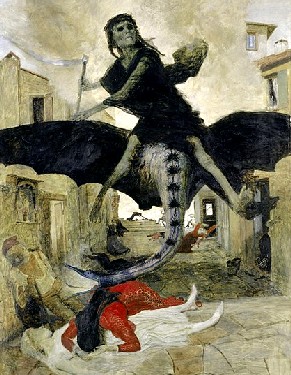
Artist: Richard Böcklin
Die Pest - A Plague Allegory (1898)
Richard Mead suggested that the virus arrived via "Contagious Particles being drawn in with the Air we breath, they taint in their Passage the Salival Juices, which being swallowed down into the Stomach presently fix their Malignity there; as appears from the Nausea and Vomiting, with which the Distemper often begins its first Attacks."1 He also noted that the virus was rapidly transferred to the blood via the lungs. Mead felt another way the illness spread was on "Goods transported from infected Places. ...the Substances found most fit ...to receive and communicate Infection, [are those such] as, Furrs, Feathers, Silk, Hair, Wool, Cotton, Flax, &c. the greatest Part of which are likewise of the Animal Kind; which Remark alone may serve to lead Us a little into the true Nature of Contagion."2
Mead also mentioned the actual cause of the plague, but only to dismiss it. He explained "that some Authors have imagined Infection to be performed by the Means of Insects, the Eggs of which may be conveyed from Place to Place, and make the Disease when they come to be hatched. As this is a supposition grounded upon no manner of Observation, so I think there is no need to have Recourse to it."3 In response to this, Joseph Browne, another English physician, said,
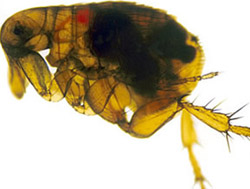
Source: NAIAD - Plague Infected Flea
"The Power and Efficacy of Worms and Insects, to procure Diseases, saith Wedelius [Georg Wolfgang Wedel], is very extensive; ...many learned Physicians and Naturalists have been, and are still of Opinion, that the Plague arises from an animated or living Putrefaction."4 However, Browne was easily dismissed during this period, having written other books which opposed the prevailing medical authors and their theories.
Today, it is known that bubonic plague is transmitted between animals and humans by infected flea bites as well as "direct contact [with other plague victims], inhalation, and, rarely, ingestion of infective material."5 Once the bacteria enters the body, it "travels through the lymphatic system to the lymph nodes, and results in painful inflammation. The septicemic form occurs when the infection spreads through the bloodstream. The pneumonic form results from inhalation of aerosolized infective droplets and can also be transmitted between humans."6
1 Richard Mead, A short discourse concerning pestilential contagion, 1720, p. 15-6; 2 Mead, p. 16-8; 3 Mead, p. 16; 4 Joseph Browne, A Practical Treatise of the Plague, 1720, p. 15; 5,6 Katerina Konstantinidou et al, Venetian Rule and Control of Plague Epidemics on the Ionian Islands during 17th and 18th Centuries, Emerging Infectious Diseases Vol. 15, No. 1, Jan 2009, p. 39
Conditions Conducive to the Plague
There were a variety of opinions on what conditions were conducive to the spread of the plague. Not surprisingly, infectious air was one the primary ones. Physician Joseph Browne said that when the air "changes often in a Day, and is sometimes hot, and then cold, now cloudy, and then clear; yet the Clouds hang low, the Air is sultry, and the Heavens threaten Rain without any falling"1, it helped spread the disease. Sea surgeon
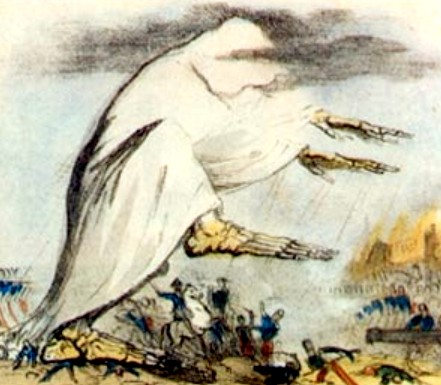
Artist: Robert Seymour
Allegorical Painting of Bad Air Causing Cholera on a Battle Field,(1831)
John Woodall suggested that plagues were spread by "Venemous and stincking vapours arising from Fens, standing ponds or pooles, Ditches, Lakes, Dunghils, Sinckes, Channels, Vaults or the like, as also uncleane slaughter-houses of Beasts, dead carkasses of men, as in time of Warre, and of stincking fish, fowle, or any thing that hath conteined life, and is putrid"2. Richard Mead explained, "A corrupted State of Air is without doubt necessary to give these Contagious Atoms their full Force"3.
The power of the air to spread diseases originated in the works of Hippocrates. Classical physicians were still very much revered by the medical community during the golden age of piracy and Hippocrates had much to say about what types of air and wind were healthy and what types were not. By way of example, he wrote that "such cities as lie to the west, and which are sheltered from winds blowing from the east, and which the hot winds and the cold winds of the north scarcely touch, must necessarily be in a very unhealthy situation"4. In detailing the healthiness of various seasons in his works, Hippocrates frequently tied both healthy and ill periods to qualities of the air. It is from such comments that physicians extrapolated the ability of the air to cause illness leading to them to suggest which environments were conducive to health and which were not.
Woodall also noted that a dirty environment was helpful to the spread of the plague. He specifically mentions the problem of cleanliness in large cities "as in London, [where] the uncleane keeping of houses, Lanes, Allies, and streetes, from those recited and the like infectious
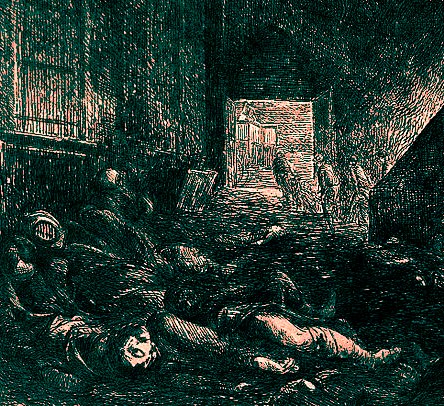
Artist: Jean-Alfred Desbrosses
Plague Victims in Squalor on a Parisian Street, Wellcome Collection (1870-1)
venomous vapours, by warmth of the Sun exhaled, are apt and able to infect the living bodies of men, and thereby to produce the Plague"5. There are two points of interest here: lack of cleanliness made plague more likely and warmth acting upon uncleanliness did the same. Physician Browne similarly mentioned countries "afflicted with Troubles and Poverty, that may throw them into a Consternation; or if Wars have been among them, whereby, from Battles, or Sieges, their Dead lie unbury'd"6.
Both these points were correct: dirty alleys and streets, there were excellent breed grounds for rats. And during the summer months, the rats reproduced more. However, as historian Carlo Cipolla points out, such observers "failed to link the phenomenon with the life cycle of rats and fleas, but they had no difficulty reconciling it with their epidemiological
theory: it was during the hottest months of the year that they smelled the foulest odors from the dirty streets, the faulty sewers, the sinks, the dung in the stables."7
Both Woodall and Browne point to food as a possible source of the plague. Woodall says that "by corrupt meats and drinkes, mens bodies are corrupted and infected... to draw [the disease] into the secretes parts of our bodies"8. Browne points to periods when "Famine happen[s], or there be too great Plenty of corrupted Meats"9. It should be noted that 'meat' is sometimes used as a generic term for food during this time. Similar to Browne, Woodall suggests that a lack of food, particularly among the poor, helped promote the plague.
Browne mentions a variety of other factors that he felt encouraged the plague. These included periods when the weather
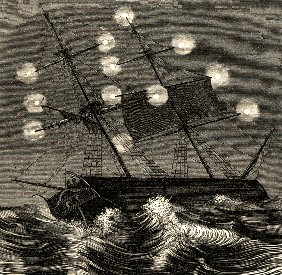
Unusual Fires in the Sky - St. Elmo's Fire, From
Naturwunder
im Reiche der Luft Wim Zimmerman (1860)
was wetter than usual, times of "Tempests or Hurricanes", plague outbreaks in neighboring countries and conditions that encourage large populations of "Insects, or Animals, as of Flies, Frogs, Snakes, Locusts, &c."10 Once again, Browne alludes to insects as a cause of the plague. He also discusses some astrological signs including "unusual Fires or Comets have appear'd in the Sky; ...Chasms or uncommon Meteors, falling Stars, and the like"11. A number of physicians during this period believed astrological conditions correlated with health.
Although ships were blamed for bringing the plague to a location, plagues were rarely reported as overtaking a ships' crew. Surgeon Patrick Russell suggested that this was because the crews "have wholesome diet, good air, and are kept in proper exercise."12 He also explained that merchant ships would be particularly able to avoid plague outbreaks because "their crew consists of a small number, and the navigation of the vessel requires the men to be much on deck."13 Russell goes on to explain, "The distemper will not spread at sea, more than on shore, without a concurrent disposition in the air; and, by early precautions in the beginning, its progress may perhaps be stopped more effectually on ship board than on shore."14 If crew members were to contract the plague on a ship, he suggests that it was "not from their being predisposed to infection

by their diet or confinement [below deck]; it consists in their lodging too near the infected body."15
Much of this theorizing is known to be incorrect today. The World Health Organization reports, "Plague is primarily a disease of rodents. The infection is maintained in natural foci [centers] of the disease in wild rodent colonies through transmission between rodents by their flea ectoparasites [external parasites]."16 Rats which get the infection but resist are able the disease then transmit it to fleas, where it lives in their stomach. These fleas' stomachs become "blocked" as the virus multiplies, causing it to remain in the esophagus. When the flea bites another victim, the virus is then regurgitated into the wound, spreading Y. pestis.17 Of the various conditions suggested by contemporary authors as causing the plague, only environment and weather conducive to an increase in the populations of rats and other plague-carrying animals would increase the likelihood of the disease spreading once the infected rats and their fleas got off an incoming ship.
1 Joseph Browne, A Practical Treatise of the Plague, 1720, p. 39; 2 John Woodall, the surgions mate, 1639, p. 326; 3 Richard Mead, A short discourse concerning pestilential contagion, 1720, p. 13; 4 Hippocrates, "On Airs, Waters and Places", The Genuine Works of Hippocrates, Vol. 1, Translated by Francis Adams, 1849, p. 195; 5 Woodall, p. 326; 6 Browne, p. 39; 7 Carlo M. Cipolla, Fighting Plague in Seventeeth-Century Italy, 1981, p. 14; 8 Woodall, p. 326; 9,10 Browne, p. 39; 11 Browne, p. 40; 12 Patrick Russell, A Treatise on the Plague, Vol. 2, 1791, p. 350; 13 Russell, p. 349; 14,15 Russell, p. 350; 16 David T. Dennis et. al., WHO Plague Manual: Epidemiology, Distribution, Surveillance and Control, 1999, p. 63; 17 Dennis et. al., p. 65
Plague Patient Symptoms
John Woodall and Joseph Browne each provide long lists of symptoms they associate with the plague.
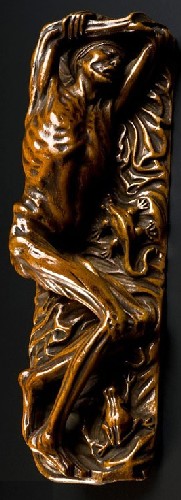
Wooden Sculpture of a Plague
Sufferer From the Wellcome Collection
(c. 1601 - 1700)
Browne lists each of them briefly, numbering them from one to eighteen, apparently in some resemblance to the order of their appearance.
The particular or special Signs of Infection, are Horror and Coldness in the outward Parts, and a preternatural Heat within; and this chiefly upon the first Accession. 2. An unquenchable Thirst. 3. An Oppression or Heaviness of the whole Body, and Lassitude of the Limbs, with a total Loss of Strength. 4. Head-Ach. 5. Sleep and immoderate Waking. 6. Delirium and Dimness of Sight. 8. Asthma. 9. Pain about the Heart, and a Profusion of cold damp Sweats. 10. Syncope [loss of consciousness] and Delirium. 11. A pointed Pain upon the Heart and Sides. 12. Frequent Vomitings and Nausea or Abhorrence of Food. 13. The Pulse either small, languid, and irregular, or else swift, furious, and intense, or otherwise attended with large Intermissions. 14. The Urine thick and muddy, and of an ill Scent. 15. The Stools fetid, frothy, often black and thin. 16. A strinking Breath, hoarseness of Voice, difficult Breathing, with a Bitterness in the Throat or Mouth. 17. In melancholy Constitutions [those with an excess of the humor black bile], the Belly is swell'd and puff'd up, as in a Tympany [swelling of the abdomen with gas]: In many, Blood flows from the Nostrils, sometimes by Stool, from the Bladder and Mouth. 18. Cold stinking Sweats will appear in some; but this is not always found.1
Browne mentions that an external indicator of the plague occurs when "many Persons die without any apparent Cause or Sickness, much about the same Time, and in the same Condition, being affected with an equal Weight or Degree of Symptoms."2 He also says that plague can be diagnosed as a cause of death when there are "Buboes [inflamed swellings] in any Part of the Body, Carbuncles [red, pus-filled bumps] or Blotches, and pestilential Wheales [red, swollen marks]. The Face appears much more horrid than that of other dead Bodies."3 The deceased's body is "as lank as a Rag dip'd in Water... [and] Stench and Putrefaction ...presently flows out of the Body"4.
Sea surgeon Woodall's discussion of plague symptoms prefaces them by noting that they "are various and uncertaine, because in truth they are seldome in any one person as in another"5. He then lists a variety of symptoms similar in many ways to Browne's. (For reference, symptoms which match Browne are noted using numbers in square brackets corresponding to his description.) Woodall's plague symptoms include:
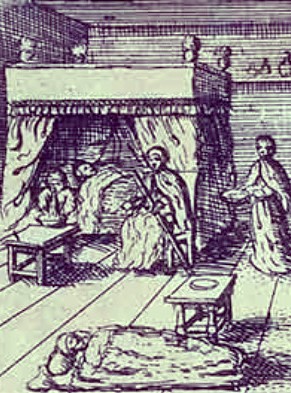
Artist: John Dunstall
Treating Plague Victims in London, From a Broadsheet
(1665)
paine in the backe... paine and giddinesse of the head [4], and paine in the stomach... a generall discouragement and weaknesse over all their whole body [3]... sences... stupefied and dulled... raging and fierce feavour... speech fayling, or fainting [10], their eyes strangely turning to and fro, in a fearfull manner. ...others complaine of an extraordinary paine, with extreame heat inward in the stomach and intrals [9], when the outward parts are chil and cold [1], and ready to shake... great thirst [2]; ...shortnesse of breath [16], and paine in breathing [8]... swelling and sorenesse of their throats [16]... the Almonds or Glandul’s of their throat much swelled and inflamed. Also many are taken with great desire to sleepe, and with frequent yawnings... Others are subject to great watchfulnesse [inability to sleep], and commonly those are in their slumbers oppressed with grievous and fearefull dreames and fantasies [5]. Others it beginneth with sweatings [9], with paine of the back, and a stinking of the breath [16]... Others have swellings in the breast, some also have losse of appetite [12], evill digestion [12], and faintnesse [10], and some are troubled with deepe hickcoks and hollow belchings [12].
Others from the beginning to the end of their sicknesse, and till death, have neither swelling sores nor spots: also upon some at first there appeare diverse spots of a duskish colour, their countenance of an unequall aspect, the one cheeke red, the other pale: Others with sweat drops on their noses, a fierce countenance with grinding of the teeth.6
Even after listing all these potential signs, Woodall again warns his reader "that no man can speake of any terrible symptom, signe, or indication of any diseases whatsoever, that hath befallen any man, but that the like hath beene seene and observed in some one person, or more, sick of the Plague"7.
Woodall then suggests that 'true' indications of the plague are found in a couple of skin problems. These include "Carbuncles [swollen, painful boils], Blotches, Blaynes [inflamed swellings], and ...spots and discolourings of the skinne... vulgarly with us, although unproperly, called Gods token, for that the pestilential Bubo and Carbuncle are by farre more manifest signes of the Plague then the spots are, for that the like spots are seene in fevers, which cannot truly be called pestilential."8 He considers such skin conditions so important that he examines each in detail.
He starts with 'the Bubo Pestilentialis', which he explains is "the first outward signe of the Plague... as I may ever justly affirme of mine owne experience"9.
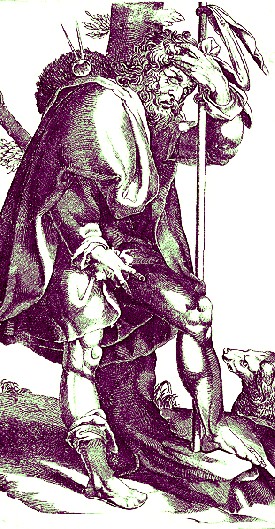
Artist: Engraving after Bartolomeo Passarotti
St. Roch, Plague Sufferer, Indicating a Bubo on
His Groin, Wellcome Collection (c. 1580)
He continues, referring to them as "Buboes, Boyles, or Pestilentiall Botches [which] commonly happen in the Emunctories, sincks, or cleansing parts of the body... and seldome elsewhere (if they be pestilential) namely ...in the glandulous parts"10. He ties bubos to the part of the body affected by pestilence. Those that appear under or behind the ears indicate "the Braine be oppressed, which ...if Nature be able, driveth out and dischargeth her selfe of the Venome or poysoned Infection" through that bubo.11 In a similar manner if pestilent bubos appear in the armpits, the heart is oppressed and if in the groin, the liver is under duress.
The second skin-based sign of the plague is "that most fierce burning Carbuncle called Anthrax, or the burning coale, which happeneth ...in every part of mans body, without order, rule or controule"12. Here, 'anthrax' does not refer to the disease of cattle, as it is commonly understood today. As Woodall's indicates, it "strictly signifies a live Coal, and figuratively a Scab or Blotch that is made by a corrosive Humour, that as it were burns the Skin, and occasions sharp pricking Pains."13 Woodall continues, advising that such carbuncles are "inflamed and hard, and in the middest thereof, with a burning payne... like to burning fire, yea and will sometimes blister, even [being accompanied] with the ardent Fevour. The shape ...is most commonly somewhat round, and the colour ...sometimes it is pale... sometimes reddish, sometimes blacke or purple or greenish"14.
The third sign is a blain, spelled 'blayne' or 'blaine' in his book. Woodall notes that while not all plague victims have blains. These are "somewhat like the small pock, but yet in colour more red or cloudy, seldome transparent, as a small pock usually is, but farre more painefull: some have them somewhat lesse, some bigger, with a small head, of an angry blew or reddish colour, sometimes of a lead colour and somewhat hard or fleshy"15. He says that while blains can be found all over the patient's body, they "seldome killeth, or hindreth the cure of the diseased, but it rather serves for a demonstrative signe of the Disease"16.
Woodall somewhat dismissively mentions "The fourth apparent outward signed of the Plague... the markes or spots appearing upon the skinne"17. He describes them as spots found "upon some bodies like Fleas bitings, in others larger, in some againe as big as a penny.... [They are]
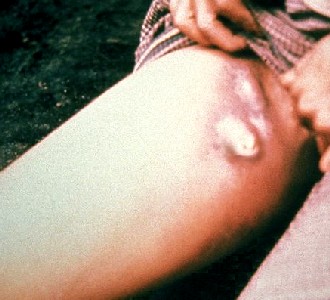
Photo: Center for Disease Control
Swollen Plague Buboes on the Leg of a Modern Patient
commonly found upon the breast, and sometimes upon the backe, armes, and legges of the patients; they are in some of a colour blewish, or of a sad red, and some are like lead colour, and others purple, some are of a pale-blew"18. He further states that they are not painful. His reference to fleas here is most interesting.
The World Health Organization's description of plague symptoms actually agrees in many ways with Woodall's latter comments. "The infection spreads via the lymphatics to the regional lymph nodes causing inflammation and swelling in one or several nodes (buboes)."19 They note that such buboes can appear in all the places Woodall mentioned - the armpit, groin and behind the ear - as well as some others such as above the collarbone, near the elbow on the forearm, behind the knee, at the back of the mouth and even internally. Some of the symptoms described by both Woodall and Browne do eventually appear including "a sudden onset of illness characterized by headache, shaking chills, fever, malaise and pain in the affected regional lymph nodes."20 When the bubo occurs internally, the WHO explains that it presents with different symptoms. Here, "abdominal pain suggestive of appendicitis, colitis, enteritis or cholecystitis may represent the patient's principal complaint."21 In his description, Woodall similarly says that patients are sometimes "afflicteth with a Dissenteria, Diarrhæa, Lienteria [lientery, diarrhea containing undigested food], all these from the belly... Also obstructions of the Bowels, retention of Urine, Colica [pain in the abdomen] and Iliaca Passio [blockage of the intestine]"22.
1 Joseph Browne, A Practical Treatise of the Plague, 1720, p. 41-2; 2 Browne, p. 41; 3,4 Browne, p. 43; 5,6 John Woodall, the surgions mate, 1639, p. p. 327; 7 Woodall, p. 328; 8 Woodall, p. 323; 9,10,11 Woodall, p. 330; 12 Woodall, p. 331; 13 John Quincy, Lexicon Physico-Medicum, 1726, p. 26; 14 Woodall, p. 331-2; 15 Woodall, p. 332-3; 16,17,18 Woodall, p. 333; 19,20 David T. Dennis et. al., WHO Plague Manual: Epidemiology, Distribution, Surveillance and Control, 1999, p. 43; 21 Dennis et. al., p. 44; 22 Woodall, p. 328
Plague Patient Signs of Impending Mortality
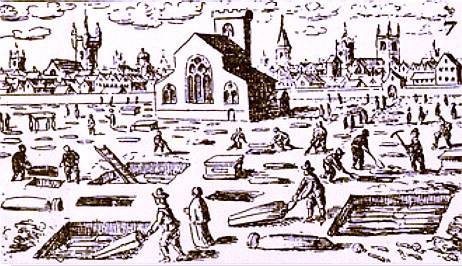
Artist: John Dustall
Mass burials During the London Plague, Taken From a Broadsheet (1665)
In addition to detailing the symptoms of plague victims, John Woodall and Joseph Browne also mention symptoms they associate with someone one in danger of dying from the plague.
Dr. Browne provides a fairly succinct list of symptoms 'which threaten and denote
nothing but Death'. These include "a frightful Countenance of the Diseased, loss of Sight and Memory, a gaping Mouth, falling Jaws, little trembling Pulse, a shaking and coldness of the Hands and Feet, a livid Nose with beating of the Nostrils;
frequent sinking of the Heart, cold Sweats and stinking Breath"1. Note that there is some overlap between these and the symptoms he listed previously.
John Woodall's list of plague symptoms 'which in this disease is commonly presage death to the partie' are different and a little less concise than Browne's. Woodall warns that the patient's demise is likely nigh
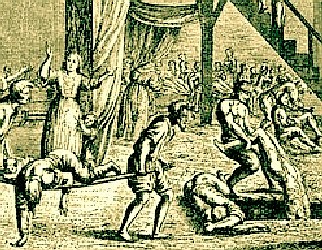
Artist: Ludovico Buinacini
The Mortally Ill, From A Plague hospital in Vienna (1679)
when the Patient is possessed with sounding ['swooning' - another word for fainting] and faintings, with cold and clammie sweats, often changing of the countenance, vomiting of slymie, sharpe, and ill-coloured flagme [phlegm], either greenish, yellowish, blackish, or bloud-coloured sanies [serum, blood or pus], or a voiding of Excrements disordered and discoloured, either fattie, blackish, unctions, or unnaturally stinking, Convulsions, Contractions of the Nerves, graveling and piddling [fiddling] with the fingers, plucking up the Bed-clothes; a sudden flux [flow] of the belly of stinking matter, of rustie or greenish colour; a sudden going back of an Apostume, Carbuncle, or Bubo; also when the Patient is insensible of the departure of his Urine and Excrements.2
However, despite his dire prediction about the life of plague patients so afflicted, Woodall goes on to state that, "by breathing of a Veine [letting blood], or giving of a good Diaphoretick [sweating] Cordiall, the partie hath been recovered and lived. Wherefore I would advise the discreet Surgeon, that dare adventure his person in such cases, not to leave doing of good to his Patient by all rationall adminstrations and applications, so long as life appeareth."3
1 Joseph Browne, A Practical Treatise of the Plague, 1720, p. 46; 2,3 John Woodall, the surgions mate, 1639, p. p. 328
Golden Age of Piracy Sailors and the Plague?
In the sailors accounts under study during the golden age of piracy, only one author suggests that members of a crew during this period contracted the plague. (In fairness, there are only a few accounts of sailors in the Mediterranean in the author's library.]
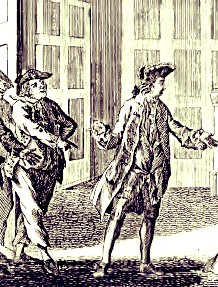
Woodes Rogers and His Men at Guayaquil
From A Universal Collection of Authentic
and
Entertaining Voyages and Travels,
Opposite
p. 86 (1765)
The infection in question began with the taking of Guayaquil in April of 1709 during Woodes Rogers privateering voyage. In his Journal, Rogers mentions that his sailors wanted to pull up a local church's floor boards, "to look amongst the Dead for Treasure... but I would not
suffer [allow] it, because of a contagious Distemper that had swept off a great Number of People here not long before; so that the Church Floor was full of Graves."1 After leaving Guayaquil, Rogers reported on May 11th they "had upwards of 20 Men that fell ill within these 24 Hours;
and our Consort [ship] near so [many], of a malignant Fever,
contracted as I suppose at Guiaquil"2. By May 24th, he noted, "There is hardly a Man in the Ship, who had been ashore at Guayaquil, but has felt something of this Distemper, whereas not one of those that were not, there have been sick yet."3 Rogers goes on to record the death of thirteen men from this illness between May 15th and June 10th.4
During this illness, the physicians in Rogers' fleet complained about a lack of medicines and it was finally decided to stop at Puerto Piña in Panama on June 14th. Here, they put all the sick men ('being about 70 in number') in the prize ship Havre de Grace. On June 28th, "we built a Tent ashore for the Sick, who are now much better than when we came to the Island", putting "the sick Men into their Tents, and put the Doctors ashore with them" the next morning.5 Edward Cooke, captain of the Rogers' consort ship Dutchess, has little to say about the illness. His May 26th, 1709 entry simply notes, "our Ships being out of Order, and our Men sickly and weak, and we had lately bury'd several Men."6 His comments don't indicate that this illness was anything unusual for such a voyage.
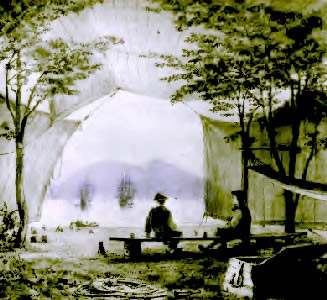
Captains Rogers and Dover Under the Pimento Trees on Juan
Fernandez
Island, From Life
Aboard a British Privateer, By
Robert Leslie, p. 60 (1889)
The label of 'plague' was applied to this illness by physician Thomas Dover, a man who had helped sponsor Roger's voyage and, for reasons known only to himself, decided to go along. In a chapter of his autobiography titled Plague, or Pestis, Dover explained that after leaving Guayaquil, that men "were taken after a violent Manner with that Languor of Spirits, that they were not able to move. I immediately went among them, and, to my great Surprize, soon discerned what was the Matter. In less than forty eight Hours we had in our several Ships one hundred and eight Men in this miserable condition."7 Dover's explanation of the rapidity of onset is clearly out of line with Roger's detailed account, written from his log of the events. Unlike Rogers, Dover was writing twenty-four years after the events occurred and may have remembered them incorrectly.
He goes on to explain that the men "had all Spots, which in the great Plague they call Tokens... and Buboes too."8 Rogers does not mention this, although he was not a medical man. Dover's rationale was "that the Plague was no more than a Fever of the most exalted Kind" and he proceeded to give them men "Oil and Spirits of Vitriol sufficient; which I caused to be mixed with Water to the Acidity of a Lemon and made them drink very freely of it; so that
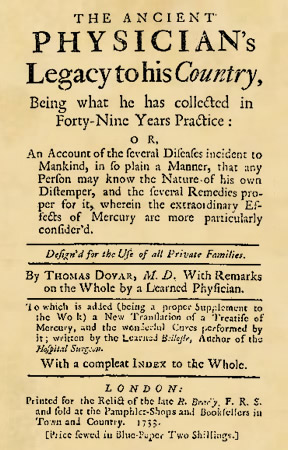
notwithstanding we had one hundred and eighty odd down in this most fatal Distemper, yet we lost no more than seven or eight"9. Here again we see that Dover's recall does not completely agree with the Captain Roger's log. Spirits of vitriol are used to purge patients, Dover's idea being that they would force out the poison that the plague brought into the body.
Although it can't be completely denied that the plague had somehow made its way from Europe to the far side of Central America in Guayaquil during a period when it was largely dormant, it seems very unlikely. It seems more plausible that this was just another one of the other fevers common to this area. As Woodall mentioned when describing plague symptoms almost 100 years earlier, spots often appeared in other fevers, including those which weren't pestilential.
It is not entirely surprising that Dover credits himself with having cured the plague in his book where the contemporary sources are less conclusive. A number of biographers hint at the self-promoting aspects of Dover's autobiography. M. P. Russel says that "the tone of The Ancient Physician's Legacy, prove Dover a somewhat arrogant, cantankerous individual."10 D.N. Phear calls Dover "Obstinate, boastful, and quarrelsome"11. William Osler says, "the spirit of the buccaneer was not dead in the old man, as no occasion is missed either to blow his own trumpet, or to tilt a lance at his colleagues."12 So it is quite possible that this wasn't an actual example of the plague, just a fever contracted in Guayaquil.
1 Woodes Rogers, A Cruising Voyage Round the World, 1712, p. 177; 2 Rogers, p. 205; 3 Rogers, p. 209; 4 Rogers, pp. 206-15; 5 Rogers, p. 218; 6 Edward Cooke, Voyage to the South Seas, Vol. 1, 1712, p. 158; 7 Thomas Dover, The Ancient Physician's Legacy, 1733, p. 67; 8,9 Dover, p. 68; 10 M. P, Russell, "Thomas Dover: 1660-1742", Edinburgh Medical Journal, 1942-04, p. 262; 11 D. N. Phear, "Thomas Dover: 1662-1742", Journal of the History of Medicine and Allied Sciences, Volume IX, Issue 2, 1 April 1954, p. 139; 12 William Osler, Thomas Dover, Physician and Buccaneer, 1896, p. 14

